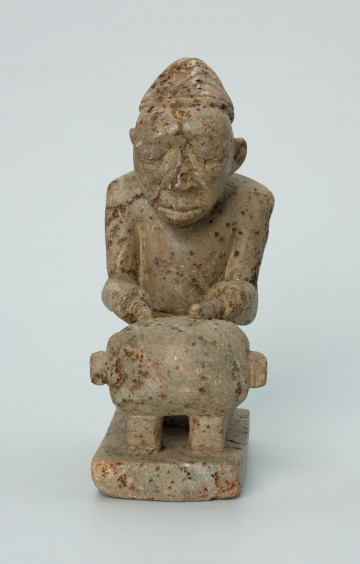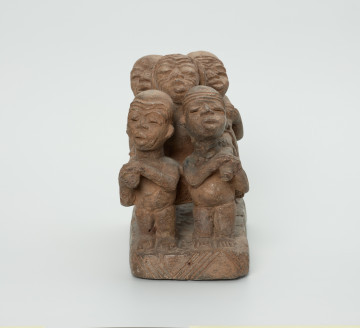
Ancestor worship figure
około 1901 — 2000
National Museum in Szczecin
Part of the collection: Mintadi figurines
The sculpture probably represents the village governor, who can be recognised by the insignia of power - a cap and a staff. Mintadi are stone figures associated with the cult of ancestors and the dead. They were carved already in the 16th century. They were mainly used to decorate and protect the graves of rulers, royal dignitaries and their wives and mothers. They are associated with the tradition and culture of the Kingdom of the Congo, which was founded in the 14th century in the lower reaches of the Congo River (present-day northern Angola, Republic of the Congo, the western Democratic Republic of the Congo). The Kingdom of the Congo was ruled by a king considered the ruler of people, things and forces that governed life and prosperity. All wealth was subject to him. He required submission, respect, tribute, loyalty and material services to maintain the state from his subjects and dignitaries. The king's real power did not extend beyond the borders of the central area. Therefore, he needed provincial chiefs, called mani in the Kikongo language. The chief mani were the king's counterparts and had the right to appoint other mani subordinates, governors, to whom they delegated part of their authority over a given territory, such as a village. The new mani were obliged to provide their superiors with tribute, which usually consisted of livestock and agricultural products. After the election of the new mani was announced, a cap-laying ceremony was held. The richly decorated mpu cap - a symbol of power - was made of silk-like fabric.
Katarzyna Findlik-Gawron
Author / creator
Dimensions
cały obiekt: height: 22,2 cm, width: 7,8 cm
Object type
sculpture
Creation time / dating
Creation / finding place
Identification number
Location / status

około 1901 — 2000
National Museum in Szczecin

około 1901 — 2000
National Museum in Szczecin

około 1901 — 2000
National Museum in Szczecin
DISCOVER this TOPIC
National Museum in Szczecin
DISCOVER this PATH
Educational path